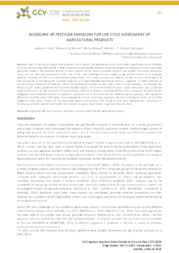Modeling of pesticide emissions for life cycle assessment of agricultural products.
Modeling of pesticide emissions for life cycle assessment of agricultural products.
Autoria: PICOLI, J. F.; BARIZON, R. R. M.; BIRKVED, M.; MATSUURA, M. I. da S. F.
Resumo: Abstract: Brazil is the fourth largest food producer in the world. The agricultural sector contributes significantly to the Bralizian economy, representing 23% of GDP in 2016. Government and private initiatives have encouraged the adoption of more sustainable production models. The potential benefits of these models can be better estimated by tools that consider the entire production chain, such as Life Cycle Assessment (LCA). One of the main challenges of LCA applied to agricultural systems is to estimate pesticide emissions to different environmental compartments. This study evaluates the influence on the environmental impacts of two approaches to estimating the pesticide emissions of a major Brazilian agricultural product, sugarcane: 1) 100% emissions to soil, according to Nemecek & Schnetzer (2011); 2) fractionated emissions to air, surface water and groundwater, according to the PestLCI v2.0.8 model, parameterized for three Brazilian regions. The environmental life cycle impact assessment was conducted using UseTox v2.0.2 for the categories of human toxicity (HT) and freshwater ecotoxicity (ETfw) impact categories. For both impact categories, environmental impacts of sugarcane production were influenced by the methodological approach, with significant differences for ETfw (about 20% higher when applying the PestLCI modelling). In general, the main contributors to the HT and ETfw categories were heavy metals and the insecticide fipronil, respectively. The results of this work highlights the importance of developing emission models that consider the complex dynamics of pesticides in agricultural production.
Ano de publicação: 2018
Tipo de publicação: Artigo em anais e proceedings
Unidade: Embrapa Meio Ambiente
Observações
1 - Por padrão são exibidas publicações dos últimos 20 anos. Para encontrar publicações mais antigas, configure o filtro ano de publicação, colocando o ano a partir do qual você deseja encontrar publicações. O filtro está na coluna da esquerda na busca acima.
2 - Para ler algumas publicações da Embrapa (apenas as que estão em formato ePub), é necessário ter, no celular ou computador, um desses softwares gratuitos. Sistemas Android: Google Play Livros; IOS: iBooks; Windows e Linux: software Calibre.
Acesse outras publicações
Acesse a Base de Dados da Pesquisa Agropecuária (BDPA) para consultar o acervo completo das bibliotecas da Embrapa.

